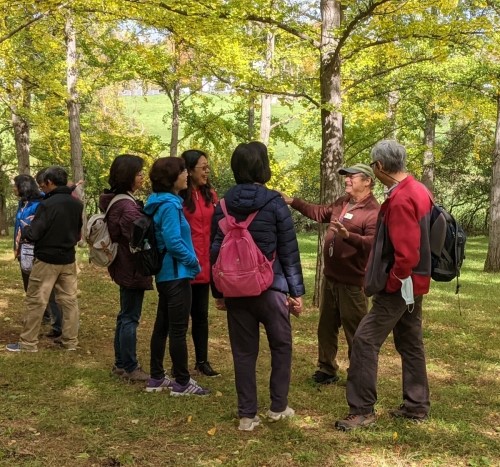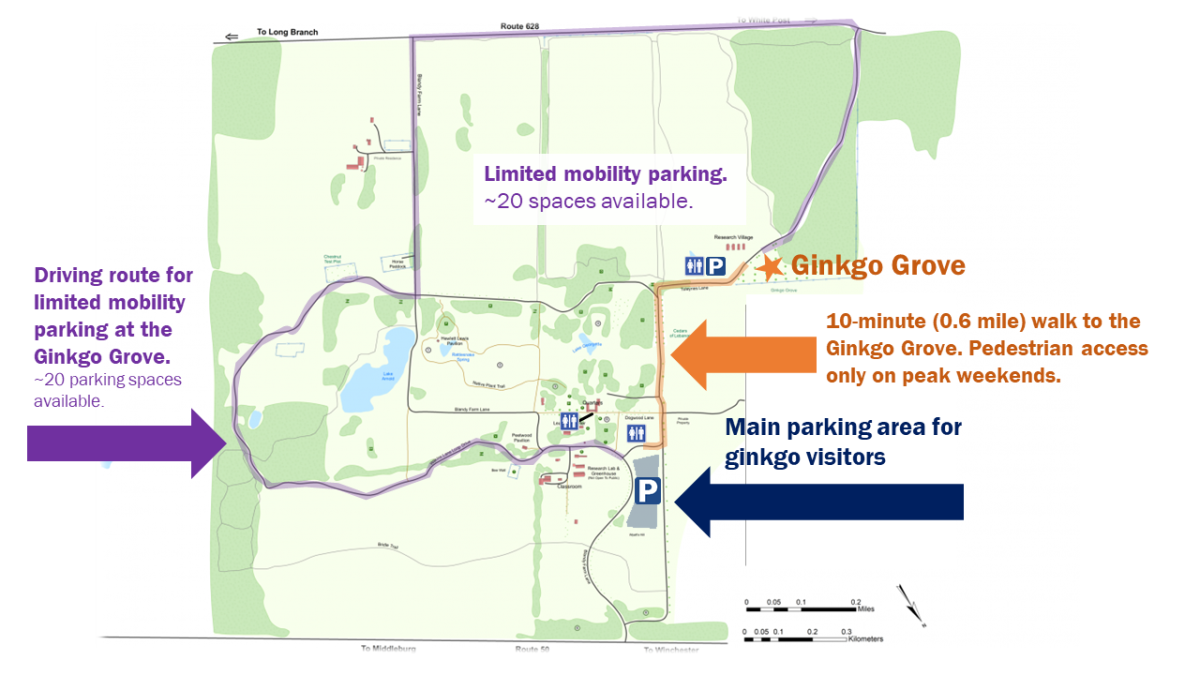GINKGO FAQS: PLANNING YOUR VISIT TO THE GINKGO GROVE

WHAT'S SO SPECIAL ABOUT BLANDY'S GINKGO GROVE?
With over 300 trees, Blandy's Ginkgo Grove is one of the largest public ginkgo groves in America. You can learn more about the Grove in our brochure!
WHEN IS THE BEST TIME TO VISIT THE GINKGO GROVE?
Although there is some variation from year to year, late October or early November is usually the best time to see glorious golden ginkgoes at Blandy. We’ll be posting regular updates about the state of the Grove on this page and on our social media pages.
The Ginkgo Grove tends to be busiest on weekends in late October and early November. "Busy" could mean over a thousand visitors a day! For a quieter experience, we strongly recommend coming on a weekday or early in the morning on a weekend. Blandy is open to the public every day from dawn to dusk.
SPECIAL VISITOR SERVICES WEEKENDS IN 2024!
This year, the Foundation of the State Arboretum will be celebrating Ginkgo Gold with special visitor services the weekends of October 26th and 27th and November 2nd and 3rd. Several snack and coffee trucks and extra bathrooms will welcome visitors near the parking entrance before you begin your 10-minute walk to the Grove. We will also host a ginkgo and State Arboretum of Virginia souvenir stand and a Sponsor A Ginkgo Tree booth across from the Gingko Grove. Learn more about how you can sponsor a ginkgo tree tagged with your name!
WHERE SHOULD I PARK?
Enter Blandy from the Route 50 entrance. Park in one of the lots near the Quarters building and enjoy the scenic, 10-minute walk to the Ginkgo Grove.
For the safety of all Blandy visitors, the route to the Ginkgo Grove along Tuleyries Lane and through the Cedars of Lebanon will only be open to pedestrian traffic during the weekends approaching "peak" golden color. There will be no direct vehicle access to the Ginkgo Grove via Tuleyries Lane during these busy weekends.
A small number of parking spaces (~20) are available at the Ginkgo Grove exclusively for visitors with limited mobility. These spaces may be accessed by following the signs through Blandy's grounds, exiting Blandy onto Berry’s Ferry road, and re-entering Blandy through the back woodlot (see map).
Please do not park or drive in non-designated areas or along roadsides as it poses a threat to the health of our trees and the safety of our visitors.

CAN TOUR BUSES DRIVE TO THE GINKGO GROVE?
No. Buses are not allowed to drive through Blandy’s grounds due to sharp turns and low-hanging tree branches. Buses must park in the front field parking lot ("Bus and Visitor") near the Quarters building. Enter Blandy from the Route 50 entrance, then turn left into the parking lot at the "Bus & Visitor Parking" sign.
ARE RESTROOMS AVAILABLE AT THE GINKGO GROVE?
Public restrooms are located at the Quarters building and at Peetwood Pavilion. Portable restrooms are also available at the Ginkgo Grove.
IS IT FREE TO SEE THE GINKGOES?
Yes! There is no admission fee to enter Blandy Experimental Farm/The State Arboretum of Virginia or to see the ginkgoes. Donations can be made here (Online Payments/Donations) to help maintain our grounds and to support our mission of environmental research and education.
WHERE CAN I LEARN MORE ABOUT GINKGOES?
There are lots of great resources out there, but here are two good places to start:
- Blandy's ginkgo brochure
- this this interview Blandy faculty and staff gave for UVA's Lifetime Learning group
WHY DOES BLANDY HAVE A GINKGO GROVE?
We can enjoy the Ginkgo Grove today thanks to a scientific experiment dating back to the 1930s and 1940s. Ginkgoes have separate male and female trees. Dr. Orland E. White, Blandy Experimental Farm’s first Director, wanted to know what proportion of a gingko’s seeds will develop into male vs. female trees. To test this question, Dr. White and his students planted an experimental ginkgo orchard at Blandy using seeds collected from a tree of the Grounds of the University of Virginia in Charlottesville. Because ginkgoes can take 20 years to reach sexual maturity, Dr. White did not live long enough to see the “fruits” of his labor and discover the answer to his question. When the final tally was made in the 1980s, 157 trees were female and 144 were male- a roughly 1:1 male:female sex ratio.
MAY I COLLECT LEAVES/FRUIT/BRANCHES AT THE GINKGO GROVE TO TAKE HOME?
No. There is a “no collecting” policy at Blandy to protect natural resources and for the enjoyment of future visitors.
DO YOU SELL GINKGO SEEDLINGS?
Not at this time.
MAY I FLY MY DRONE OVER THE GINKGO GROVE?
No. Drones are prohibited at Blandy.


